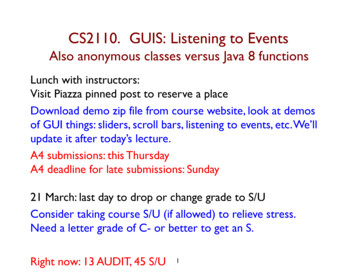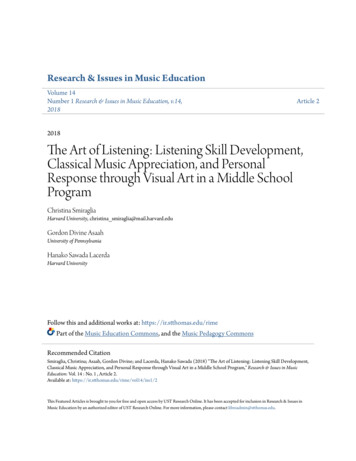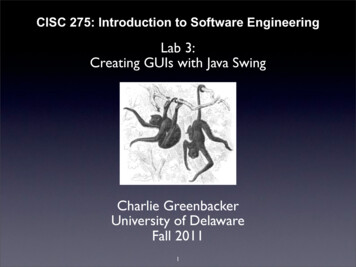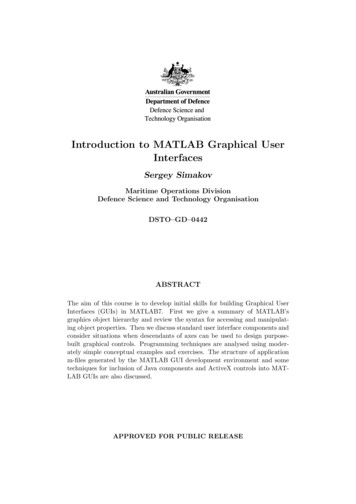
Transcription
CS2110. GUIS: Listening to EventsAlso anonymous classes versus Java 8 functionsLunch with instructors:Visit Piazza pinned post to reserve a placeDownload demo zip file from course website, look at demosof GUI things: sliders, scroll bars, listening to events, etc. We’llupdate it after today’s lecture.A4 submissions: this ThursdayA4 deadline for late submissions: Sunday21 March: last day to drop or change grade to S/UConsider taking course S/U (if allowed) to relieve stress.Need a letter grade of C- or better to get an S.Right now: 13 AUDIT, 45 S/U1
ButtonJLabelSquare Square Square SquareJLabelJLabelLayout Manager for Checkersgame has to process a treeboardBox: vertical Boxrow: horizontal Boxpack(): Traverse the tree,Square: Canvas or JPaneldetermining the space requiredinfoBox: vertical Boxfor each componentrow row2
Listening to events: mouse click, mouse movementinto or out of a window, a keystroke, etc. An event is a mouse click, a mouse movement into or out of awindow, a keystroke, etc. To be able to listen to a kind of event, you have to:1. Have some class C implement an interface IN that isconnected with the event.2. In class C, override methods required by interface IN; thesemethods are generally called when the event happens.3. Register an object of class C as a listener for the event. Thatobject’s methods will be called when event happens.We show you how to do this for clicks on buttons, clicks oncomponents, and keystrokes.3
Anonymous functionsYou know about interfaceComparable.public interface Comparable T {/** Return neg, 0 or pos */int compareTo(T ob);}public abstract class Shape implements Comparable { /** Return the area of this shape */In some class:public abstract double area() ;Shape[] s ;/** Return neg, 0, or pos */public int compareTo(Shape ob) { }}4 Arrays.sort(s);Use an anonymous functionto make this easier!
Anonymous functionsYou know about interfaceComparable.public interface Comparable T {/** Return neg, 0 or pos */int compareTo(T ob);}public abstract class Shape implements Comparable { /** Return the area of this shape */In some class:public abstract double area() ;Shape[] s ;/** Return neg, 0, or pos */public int compareTo(Shape ob) { }}5 Arrays.sort(s);Use an anonymous functionto make this easier!
Anonymous functionsHere is a function:public int f(Person b, Person c) {return b.age – c.age;}Written as an anonymous functionpublic class Person {public String name;public int age; }(Person b, Person c) - b.age – c.ageAnonymous because it does not have a name.Don’t need keyword return. Can put braces around thebody if it is more than a single expression.Depending on where it is written, don’t need to put intypes of b, c if the types can be inferred.6
Anonymous functionsIn some class:Person p[] new Person[10]; code to put in 10 Persons public class Person {public String name;public int age; }/** Sort p on ageArrays.sort(p, (Person b, Person c) - b.age – c.age);/** Sort p in descending order of ageArrays.sort(p, (b, c) - c.age – b.age);When Java compiles these calls, it will eliminate theanonymous functions and turn it into code that usesinterface Comparable! This is “syntactic sugar”!We use anonymous functions to listen to button clicks.7
What is a JButton?Instance: associated with a “button” on the GUI,which can be clicked to do somethingjb1 new JButton()// jb1 has no text on itjb2 new JButton(“first”) // jb2 has label “first” on itjb2.isEnabled()jb2.setEnabled(b);// true iff a click on button can be// detected// Set enabled propertyjb2.addActionListener(object); // object must have a method,// which is called when button jb2 clicked (next page)At least 100 more methods; these are most importantJButton is in package javax.swing8
Listening to a JButton1. Implement interface ActionListener:public class C extends JFrameimplements ActionListener { }So, C must implement actionPerformed, and it will be calledwhen the button is clickedpublic interface ActionListener extends {/** Called when an action occurs. */public abstract void actionPerformed(ActionEvent e);}9
Listening to a JButton1. Implement interface ActionListener:public class C extends JFrameimplements ActionListener { }2. In C override actionPerformed --called when button is clicked:/** Process click of button */public void actionPerformed(ActionEvent e) { }public interface ActionListener extends EventListener {/** Called when an action occurs. */public abstract void actionPerformed(ActionEvent e);}10
Listening to a JButton1. Implement interface ActionListener:public class C extends JFrameimplements ActionListener { }2. In C override actionPerformed --called when button is clicked:/** Process click of button */public void actionPerformed(ActionEvent e) { }3. Add an instance of class C an action listener for button:button.addActionListener(this);But instead, we use an anonymous function!Method Jbutton.addActionListenerpublic void addActionListener(ActionListener l)11
/** USE anonymous function */class ButtonDemo1 extends JFrame {/** exactly one of eastB, westB is enabled */JButton westB new JButton("west");JButton eastB new JButton("east");red: listeningblue: placingpublic ButtonDemo1(String t) {super(t);Add listener toadd(westB, BLayout.WEST);westB the same wayadd(eastB, BLayout, e);eastB.addActionListener(e - {boolean b abled(b);});Listening to a ButtonButtonDemo112
/** Save anonymous function in local var*/class ButtonDemo1 extends JFrame {/** exactly one of eastB, westB is enabled */JButton westB new JButton("west");JButton eastB new JButton("east");red: listeningblue: placingpublic ButtonDemo1(String t) {super(t);add(westB, B, BLayout, (false);pack(); ener al e - {boolean b abled(b);};ButtonDemo1Listening to a Button13
A JPanel that is paintedMouseDemo2 The JFrame has a JPanel in its CENTERand a reset button in its SOUTH. The JPanel has a horizontal box b, which containstwo vertical Boxes. Each vertical Box contains two instances of class Square. Click a Square that has no pink circle, and a pink circle is drawn.Click a square that has a pink circle, and the pink circledisappears.Click the rest button and all pink circles disappear. This GUI has to listen to:(1) a click on Button reset(2)a clicka Squarekinds(a Box)Theseareondifferentofevents, and they needdifferent listener methods14
/** Instance: JPanel of size (WIDTH, HEIGHT).Green or red: */public class Square extends JPanel {public static final int HEIGHT 70;public static final int WIDTH 70;private int x, y; // Panel is at (x, y)private boolean hasDisk false;/** Const: square at (x, y). Red/green? Parity of x y. */public Square(int x, int y) {Classthis.x x;this.y y;SquaresetPreferredSize(new Dimension(WIDTH, HEIGHT));}/** Complement the "has pink disk" property */public void complementDisk() {continued on laterhasDisk ! hasDisk;repaint(); // Ask the system to repaint the square}15
JPanel, JFrame, and Canvas have a methodpaint(Graphics g) //does nothingOverride it to “paint” on the component (below).When the operating system needs the componentto be repainted, it calls method paint.When your code needs to have it repainted, callinherited method repaint()./** Complement the "has pink disk" property */public void complementDisk() {hasDisk ! hasDisk;repaint(); // Ask the system to repaint the square}16ClassSquare
Class GraphicsAn object of abstract class Graphics has methods to draw on acomponent (e.g. on a JPanel, or canvas).Major methods:drawString(“abc”, 20, 30);drawRect(x, y, width, height);drawOval(x, y, width, height);setColor(Color.red);getFont()More methodsdrawLine(x1, y1, x2, y2);fillRect(x, y, width, height);fillOval(x, y, width, height);getColor()setFont(Font f);You won’t create an object of Graphics; you will begiven one to use when you want to paint a componentGraphics is in package java.awt17
continuation of class Square/** Paint this square using g. System callspaint whenever square has to be redrawn.*/public void paint(Graphics g) {if ((x y)%2 0) g.setColor(Color.green);else g.setColor(Color.red);g.fillRect(0, 0, WIDTH-1, HEIGHT-1);if (hasDisk) {g.setColor(Color.pink);g.fillOval(7, 7, WIDTH-14, HEIGHT-14);}ClassSquare/** Remove pink disk(if present) */public void clearDisk() {hasDisk false;// Ask system to// repaint t(0, 0, WIDTH-1,HEIGHT-1);g.drawString("(" x ", " y ")", 10, 5 HEIGHT/2);}}18
Listen to mouse event(click, press, release, enter, leave on a component)public interface MouseListener {In package java.awt.eventvoid mouseClicked(MouseEvent e);void mouseEntered(MouseEvent e);void mouseExited(MouseEvent e);void mousePressed(MouseEvent e);void mouseReleased(MouseEvent e);}Having write all of these in a class that implementsMouseListener, even though you don’t want to use allof them, can be a pain. So, a class is provided thatimplements them in a painless way.19
Listen to mouse event(click, press, release, enter, leave on a component)In package java.swing.eventMouseEventspublic class MouseInputAdaptorimplements MouseListener, MouseInputListener {public void mouseClicked(MouseEvent e) {}public void mouseEntered(MouseEvent e) {}public void mouseExited(MouseEvent e) {}public void mousePressed(MouseEvent e) {}public void mouseReleased(MouseEvent e) {} others So, just write a subclass of MouseInputAdaptor and} override only the methods appropriate for the application20
Javax.swing.event.MouseInputAdapterimplements )MouseEventsmouseClicked() { }a2JFrame MouseDemo2me a1b00 b01 MouseDemo2() { b00.addMouseListener(me); }21
A class that listens to aimport javax.swing.*;import javax.swing.event.*; mouseclick in a Squareimport java.awt.*;red: listeningimport java.awt.event.*;blue: placing/** Contains a method that responds to amouse click in a Square */public class MouseEventsThis class has several methodsextends MouseInputAdapter {(that do nothing) to process// Complement "has pink disk" propertymouse events:mouse clickpublic void mouseClicked(MouseEvent e) {mouse pressObject ob e.getSource();mouse releaseif (ob instanceof Square) {mouse enters component((Square)ob).complementDisk();mouse leaves component}mouse dragged beginning in}component}Our class overrides only the method that processes mouse clicks22
jb.addActionListener(public class MD2 extends JFramee - clearDisks(e));implements ActionListener {b00.addMouseListener(me);Box b new Box( X AXIS);b01.addMouseListener(me);Box leftC new Box( Y AXIS);b10.addMouseListener(me);Square b00, b01 new squares;b11.addMouseListener(me);Box riteC new Box(.Y AXIS);}Square b10, b01 new squares;public void clearDisks(JButton jb new JButton("reset");ActionEvent e) {MouseEvents me call clearDisk() fornew MouseEvents();b00, b01, b10, b11}/** Constructor: */public MouseDemo2() {red: listeningsuper(“MouseDemo2”);blue: placingplace components in JFrame;pack, make unresizeable, visible;MouseDemo223
Listening to the keyboardimport java.awt.*;import java.awt.event.*;import javax.swing.*;public class AllCaps extends KeyAdapter {JFrame capsFrame new JFrame();JLabel capsLabel new JLabel();red: listeningblue: placing1. Extend this class.public AllCaps() ENTER);capsLabel.setText(":)");3. Add this instance as acapsFrame.setSize(200,200);key listener for the frameContainer c capsFrame.getContentPane();c.add(capsLabel);2. Override this method.capsFrame.addKeyListener(this);It is called when a keycapsFrame.show();stroke is detected.}public void keyPressed (KeyEvent e) {char typedChar e.getKeyChar();capsLabel.setText(("'" typedChar "'").toUpperCase());}}24
public class BDemo3 extends JFrame {private JButton wB, eB ;public ButtonDemo3() {Add buttons to JFrame, w BeListener());}Have a differentlistener for eachbuttonpublic void disableE(ActionEvent e) {eB.setEnabled(false); wB.setEnabled(true);}public void disableW(ActionEvent e) {eB.setEnabled(true); wB.setEnabled(false);}}ButtonDemo3}25
ANONYMOUS CLASSYou will see anonymous classes in A5 and other GUI programsUse sparingly, and only when the anonymous classhas 1 or 2 methods in it,because the syntax is ugly, complex, hard to understand.The last two slides of this ppt show you how to eliminateBeListener by introducing an anonymous class.You do not have to master this material26
Have a class for which only one object is created?Use an anonymous class.Use sparingly, and only when the anonymous class has 1 or 2 methodsin it, because the syntax is ugly, complex, hard to understand.public class BDemo3 extends JFrame implements ActionListener {private JButton wButt, eButt ;public ButtonDemo3() { eButt.addActionListener(new BeListener());}public void actionPerformed(ActionEvent e) { }private class BeListener implements ActionListener {public void actionPerformed(ActionEvent e) { body }}}1 object of BeListener created. Ripe for making anonymous27
Making class anonymous will replace new BeListener()Expression that creates object of BeListenereButt.addActionListener( new BeListener () );private class BeListener implements ActionListener{ declarations in class }}2. Use name of interface thatBeListener implements1. Write new2. Write new ActionListener3. Write new ActionListener ()4. Write new ActionListener (){ declarations in class }3. Put in arguments ofconstructor call4. Put in class body5. Replace new BeListener() by new-expression28
ANONYMOUS CLASS IN A5.PaintGUI. setUpMenuBar, fixing item “New”Fix it so thatcontrol-Nselects thismenu itemSave new JMenuItemnew ActionListener() { } declares an anonymousclass and creates an object of it. The class implementsActionListener. Purpose: call newAction(e) whenactionPerformed is called29
Using an A5 function (only in Java 8!.PaintGUI. setUpMenuBar, fixing item “New”Fix it so thatcontrol-Nselects thismenu itemSave new JMenuItemargument e - { newAction(e);}of addActionListener is a function that, when called, callsnewAction(e).30
ANONYMOUS CLASS VERSUS FUNCTION CALLPaintGUI. setUpMenuBar, fixing item “New”The Java 8 compiler will change this:newItem.addActionListener(e - { newAction(e); });back into this:newItem.addActionListener(new ActionListener() {public void actionPerformed(ActionEvent e) {newAction(e);}});and actually change that back into an inner class31
into or out of a window, a keystroke, etc. An eventis a mouse click, a mouse movement into or out of a window, a keystroke, etc. To be able to listen to a kind of event, you have to: 1.Have some class C implement an interface IN that is connected with the event. 2.In class C, override methods required by interface IN; these










